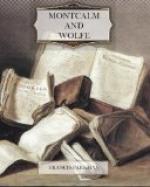NOTE: The Journal of Celoron (Archives de la Marine) is very long and circumstantial, including the proces verbaux, and reports of councils with Indians. The Journal of the chaplain, Bonnecamp (Depot de la Marine), is shorter, but is the work of an intelligent and observing man. The author, a Jesuit, was skilled in mathematics, made daily observations, and constructed a map of the route, still preserved at the Depot de la Marine. Concurrently with these French narratives, one may consult the English letters and documents bearing on the same subjects, in the Colonial Records of Pennsylvania, the Archives of Pennsylvania, and the Colonial Documents of New York.
Three of Celeron’s leaden plates have been found,—the two mentioned in the text, and another which was never buried, and which the Indians, who regarded these mysterious tablets as “bad medicine,” procured by a trick from Joncaire, or, according to Governor Clinton, stole from him. A Cayuga chief brought it to Colonel Johnson, on the Mohawk, who interpreted the “Devilish writing” in such a manner as best to inspire horror of French designs.
Chapter 3
1749-1753
Conflict for the West
The Iroquois, or Five Nations, sometimes called Six Nations after the Tuscaroras joined them, had been a power of high importance in American international politics. In a certain sense they may be said to have held the balance between their French and English neighbors; but their relative influence had of late declined. So many of them had emigrated and joined the tribes of the Ohio, that the centre of Indian population had passed to that region. Nevertheless, the Five Nations were still strong enough in their ancient abodes to make their alliance an object of the utmost consequence to both the European rivals. At the western end of their “Long House,” or belt of confederated villages, Joncaire intrigued to gain them for France; while in the east he was counteracted by the young colonel of militia, William Johnson, who lived on the Mohawk, and was already well skilled in managing Indians. Johnson sometimes lost his temper; and once wrote to Governor Clinton to complain of the “confounded wicked things the French had infused into the Indians’ heads; among the rest that the English were determined, the first opportunity, to destroy them all. I assure your Excellency I had hard work to beat these and several other cursed villanous things, told them by the French, out of their heads."[26]
[Footnote 26: Johnson to Clinton, 28 April, 1749.]




